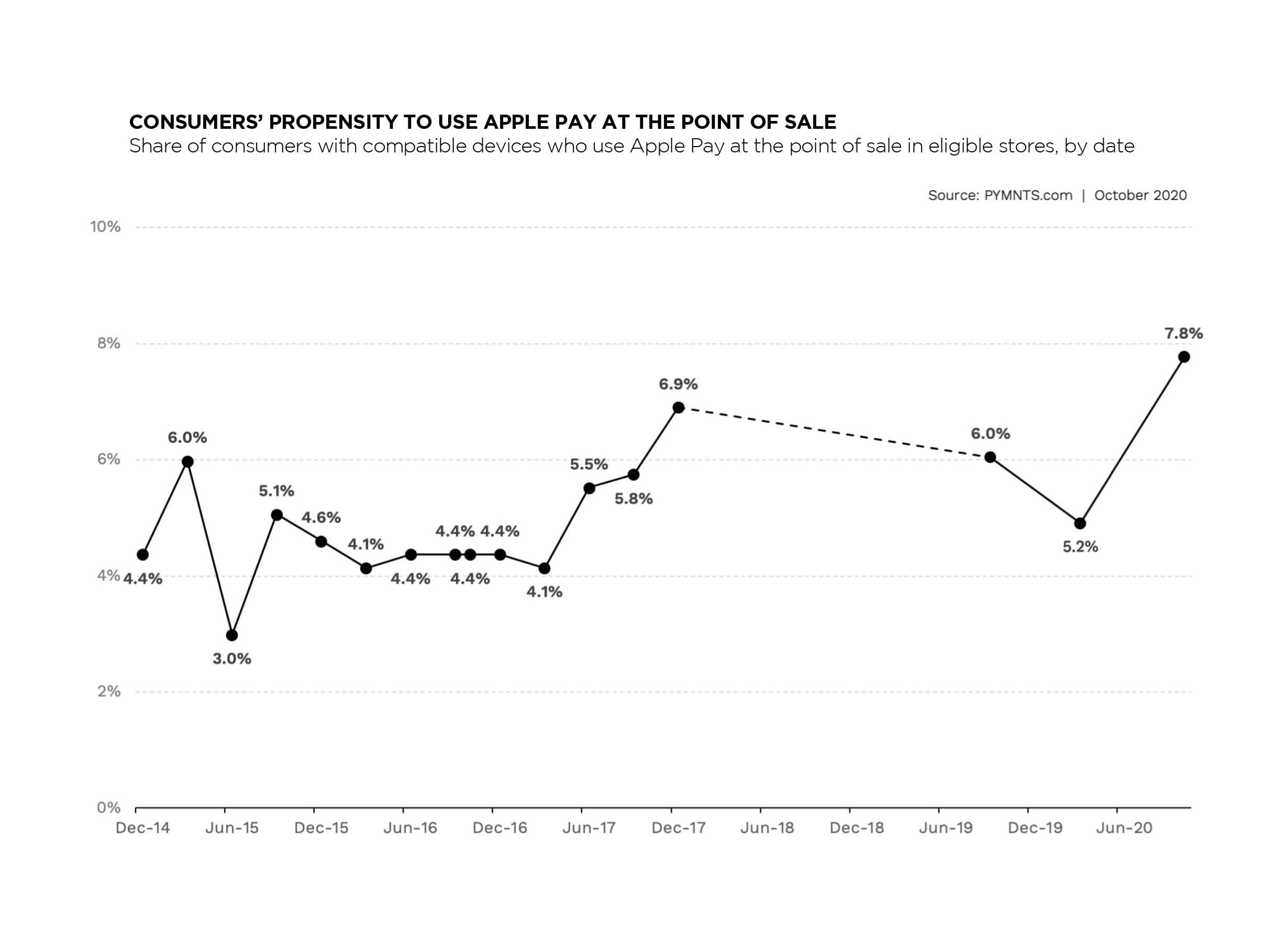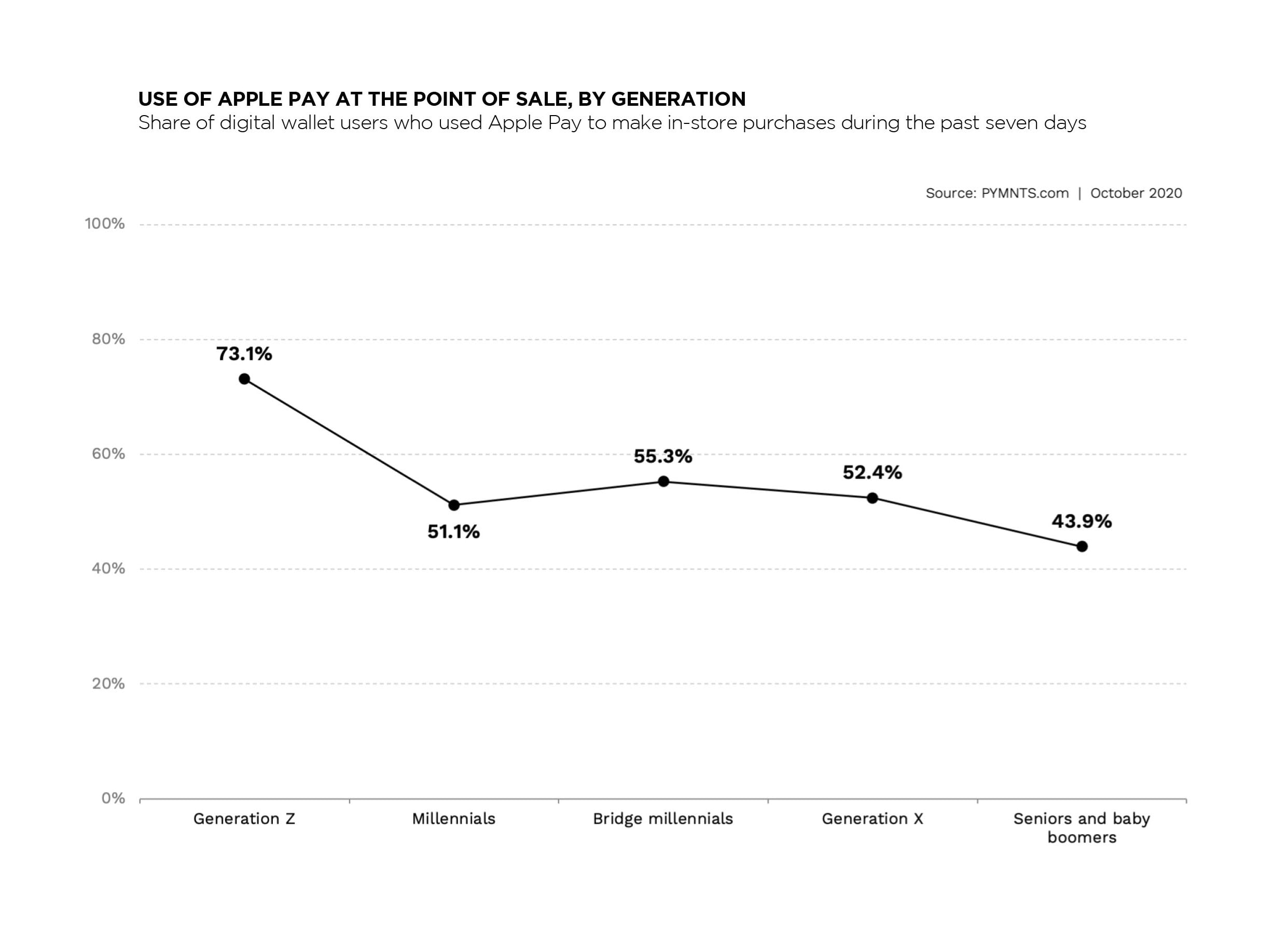
Apple has been manufacturing its own luck since the dawn of the 21st century, with iPods, a multitude of MacBooks, iPads, wearables and seemingly ubiquitous Apple iPhones coming to stand for tech innovation at its coolest and most consumerized.
Whether it’s luck, business smarts or a combination of both, new PYMNTS research shows that use of the Apple Pay mobile wallet at brick-and-mortar stores spiked 59 percent from March, “after an extended period of stagnation in Apple Pay use,” according to a new report.
When the mobile Apple Wallet debuted six years ago, word was it was going to do to charge cards what iPods did to CD players. Things didn’t play out quite that way. In fact, it took a global pandemic to get consumers really thinking about mobile wallets and using them. Finally.
PYMNTS has tracked Apple Pay adoption since 2014. This year we surveyed a census-balanced panel of nearly 3,000 U.S. consumers to find out what’s up with Apple Pay in physical stores during the year of COVID. The latest report, Apple Pay At 6: How Consumers Are Using The Mobile Wallet To Make Purchases At The Physical POS, shows life in mobile wallets.
“Our latest research shows that consumer demand for contactless ways to shop and pay during the COVID-19 pandemic is fueling an increase in the use of Apple Pay in brick-and-mortar stores. Apple Pay use for in-store transactions has gone up by 59 percent, with 7.8 percent of consumers who have Apple Pay-enabled phones now using the mobile wallet to make POS payments at eligible stores — up from 4.9 percent in March,” according to Apple Pay At 6.

Touch-Free Gives Apple Pay Renewed Purpose
About 208 million Americans own smartphones with a mobile wallet feature, and “Our research shows that 36.4 percent of all consumers in the United States have smartphones that are compatible with Apple Pay as of Q3 2020. This represents a 1.2 percent growth rate from Q1 2020 and a year-over-year growth rate of just 6.6 percent from 2019. Apple Pay-compatible device ownership increased at a rate of about 17.2 percent between 2017 and 2019 by comparison. Before then, its size tripled between 2015 and 2017.”
True, but there is that previously-mentioned March spike and its wider implications.
“[The] demand for touch-free shopping experiences has been fueling an increased use of Apple Pay in recent months. Our research shows that use of Apple Pay at brick and mortar stores is up by 59 percent from March,” per the new report. Whether it sticks and grows, no one yet knows.
The report adds that “More than 58 percent of consumers are now using digital channels to make purchases so they can avoid having to stand in line,” adding that “This demand for touch-free shopping experiences has been fueling an increased use of Apple Pay in recent months.”

Attributes Of Apple Pay Users
Wider trends in digital stand out in Apple Pay At 6: How Consumers Are Using The Mobile Wallet To Make Purchases At The Physical POS. An example is the pull of contactless.
“A significant share of consumers have migrated to digital channels for ordering food and buying weekly groceries, but they are embracing contactless options such as Apple Pay when it comes to shopping with mass merchants. Our research shows that more than 49 percent of Apple Pay transactions are done at mass merchant stores,” the study states.
That explains some of the “where.” As it pertains to “who” the heaviest users of Apple Pay are on its sixth birthday, that finding leaps right out of the data. It’s younger, affluent women.
“When it comes to deciding between various mobile wallet options, 52 percent of consumers in our survey report choosing Apple Pay at the POS. These users tend to be younger, female and more affluent and educated,” according to Apple Pay At 6, adding that “73.1 percent of Generation Z digital wallet users used Apple Pay when making an in-store purchase in the last seven days — a share that was nearly 52 percent for both millennial and Generation X users.”
